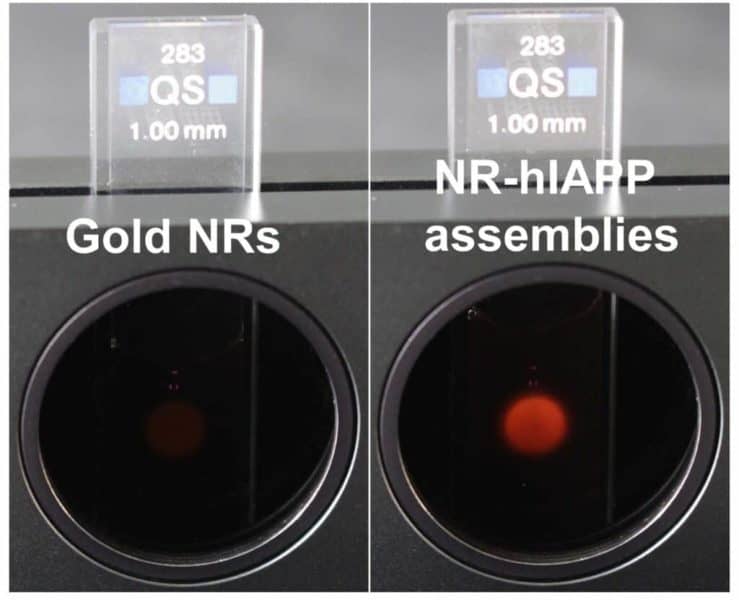In a new drug screening technique that relies on gold nanorods to twist light, a red glow can signal the failure of a medication being designed to treat “amyloid” diseases such as Type II diabetes and pancreatic cancer.
The technique was developed by researchers from the University of Michigan, Jilin University in China and the Federal University of São Carlos in Brazil. It harnesses a property called “chirality,” which is found in nanostructures, biological molecules like proteins, and lightwaves. A chiral object cannot be superimposed on its mirror image, like a left and right hand, or helices that twist in different directions.
The researchers were able to take advantage of the chirality of a protein marker for these diseases, called islet amyloid polypeptides. These proteins link up into twisted chains and accumulate in tissues. Amyloid proteins that form corkscrew-shaped fibers also play a role in Parkinson’s and Huntington’s diseases.
In the new approach, chiral gold nanorods are coated with the harmful proteins, which form long spring-shaped fibers with three nanorods per turn. These structures appear bright red when viewed between two oppositely angled polarizers, or light filters, because their twisting, chiral shapes can turn the polarization of the light.

In a device that can reveal whether amyloid proteins are assembling into chains, unpolarized light enters a horizontal polarizer. This only allows waves oscillating in the horizontal direction to get through. Then, if the amyloid proteins have assembled the gold nanorods into chains, red light gets twisted, changing the angle of its polarization. Then, when it passes through the vertical polarizer, the portion of the light oscillating in the vertical direction gets through. This results in a strong red signal that can be seen with the naked eye. Credit: Jun Lu, Jilin University and University of Michigan.
“The strong twisting of the light allows for the drug screening results to be seen with the naked eye, instead of using complicated instruments,” said Kun Liu, a professor of chemistry at Jilin University and co-corresponding author on a study newly published in Science.
The nanorods—each about 50 nanometers long and 20 nanometers wide—offer additional benefits.
“The periodic helical chains increase the twisting of light by 4,600 times, which makes them visible under very difficult biological conditions. And the nanorods also speed up the process of forming amyloid chains, which is critical for rapid drug discovery,” said Nicholas Kotov, co-corresponding author and the Irving Langmuir Distinguished University Professor of Chemical Sciences and Engineering at U-M.
Typically, amyloid polypeptides take a few days to a week to link up, which slows down the testing of potential drugs. The nanorods accelerate the process to one day. This occurs because the rods are coated with a surfactant chemical called cetrimonium bromide, similar to the cetrimonium chloride found in some shampoos and conditioners. When the amyloid proteins bind to the barrel of the gold rod, the surfactant helps them to form a coiled shape that facilitates bonding to other amyloids.
When the amyloids connect, their gold rods form a helix, twisting around the protein rope. And because the gold interacts strongly with red light, these highly organized helices twist red light waves very strongly.
This is what leads to the easy detection of whether a drug to prevent amyloid chains has worked or not. The set-up puts the realistic mixture of cells, blood components, drug molecules and amyloid proteins that drugs encounter in the body in between two polarizers. The first polarizer only allows light to pass if it oscillates in the vertical direction. The second polarizer only passes light waves moving in the horizontal direction.

The view through the polarizer shows where light-twisting structures have formed in a soup of cells and biological materials. Credit: Jun Lu, Jilin University and University of Michigan.
If the light doesn’t twist between the two polarizers, the two polarizers fully block the light. This is what happens when a drug is successful: No amyloid chains form, so only a few random nanorods are twisting light. Very little light comes through the two polarizers. However, if those chains form, they twist red light. A red glow becomes clearly visible—showing that the drug has failed.
“While the experiments fine-tuned the conditions best for detecting amyloid chains, the computer simulations were fundamental to unraveling the complex interactions between gold, surfactants and the protein fragments, which need to interact simultaneously to make the platform work,” said co-author André de Moura, a professor at the Federal University of São Carlos.
The international team also established unifying design principles for how to make twisted nanostructures that can significantly twist light, which is critical for many applications.
The study is titled “Enhancement of optical asymmetry in supramolecular chiroplasmonic assemblies with long-range order.” It was funded by the National Natural Science Foundation of China; Jilin University; Open Project of State Key Laboratory of Supramolecular Structure and Materials; Brazilian funding agencies CAPES, CNPq and FAPESP; National Science Foundation; and Office of Naval Research. Kotov is also the Joseph B. and Florence V. Cejka Professor of Chemical Engineering.


